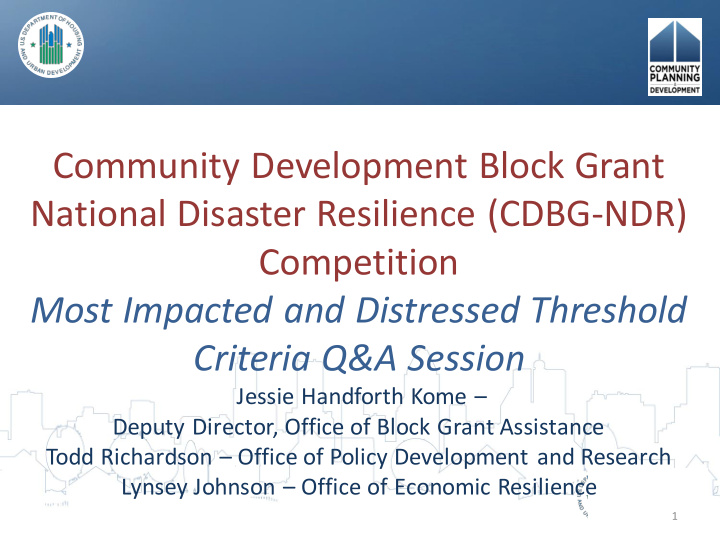



Community Development Block Grant National Disaster Resilience (CDBG-NDR) Competition Most Impacted and Distressed Threshold Criteria Q&A Session Jessie Handforth Kome – Deputy Director, Office of Block Grant Assistance Todd Richardson – Office of Policy Development and Research Lynsey Johnson – Office of Economic Resilience 1
Agenda 1. Brief Review - Most Impacted and Distressed Threshold Criteria 2. Q & A 3. Resources 2
Most Impacted, Distressed and Unmet Recovery Need Thresholds • Where did the disaster do damage? • How much damage was done? Most Impacted • What characteristics of the most impacted area exacerbate the impact of the disaster and make it more difficult to recover? Distressed • What need resulting from the disaster remains in the most impacted area that cannot be met with available Unmet Recovery resources? Need 3
Most Impacted and Most Distressed Thresholds The “most impacted and distressed” (MID) thresholds: • This appropriation provides for certain recovery assistance “in the most impacted and distressed areas resulting from a major disaster declared pursuant to the Robert T. Stafford Disaster Relief and Emergency Assistance Act ” due to Hurricane Sandy and other eligible events in calendar years 2011, 2012, and 2013 . . . Thursday: unmet recovery needs (URN) threshold 4
MID Threshold Criteria • HUD Disaster Recovery allocations must be based on “best available data” • No current data for remaining unmet recovery needs for 2011, 2012 and 2013 disasters HUD must rely on Applicant data to make allocations Applicant data must meet same standards HUD uses when making CDBG-DR formula allocations • Threshold Criteria detailed in CDBG-NDR NOFA - Appendix G • Submissions that fail to demonstrate Unmet Recovery Need in a Most Impacted and Distressed area will be deemed unresponsive 5
What is a target area? • For MID- URN threshold (Appendix G Threshold or Factor minimum) • Target area = MID-URN demonstrated area: • County-level for HUD-designated Most Impacted Counties “Most Impacted Counties (MIC)” tab in NOFA Appendix B; OR • Sub-county-level for all other declared counties “Declared Counties by Disaster” tab in NOFA Appendix B • MAY NOT be in non-declared counties • MUST meet at least one most impacted, at least one distressed AND at least one unmet recovery criteria described in Attachment G to the NDRC NOFA • CDBG-NDR grant funds may ONLY be used to assist MID-URN areas For NDRC overall proposals (Beyond Factor minimum) • Target area = Overall area proposed for resilience • MID-URN areas + leverage/long-term commitment areas 6
Why is the MID-URN target area definition important? • Because the law says “MOST” impacted and applicants must make choices and demonstrate what “most” is in their jurisdictions. • Because the amounts of housing and business impact in Appendix G are calibrated to be appropriate at the census tract level. • Because HUD is looking for a fundable scale for projects within the total eligible geography. 7
What is sub-county level? A “county” is the county or county equivalent that received the major disaster declaration from FEMA. This includes parishes, boroughs, independent cities, the District of Columbia, and Educational Attendance Areas. Tribal areas . A census tract. A place name so long as the area is a smaller geographic area within the declared county, but the response to the thresholds must address the entire geographic area within the place (e.g., if the place is an city that is part of the county that received the designation, the data must address the entire place, not just a few census tracts or block groups within that city). A group of aggregated, contiguous census tracts that together represent a smaller geographic area within a county. County-equivalents like independent cities that received their own disaster declarations (including the District of Columbia) are not “sub - county areas” and therefore must provide data and responses for a sub-county area at the level of a census tract or group of contiguous census tracts. 8
Can a county be a sub-county? • Sub-county-level – Census place – Census tract or group of contiguous tracts Q: Can an applicant make a MID showing for EVERY subcounty area within a county that separately addresses the data for each and every subcounty area (census tract, census place)? A: Yes. Although an Applicant may not aggregate data to meet MID for a group of subcounty areas, an applicant may separately make a demonstration for each census tract (or group of contiguous census tracts that makes up a place) in the entire county. 9
MID Responses • Phase 1 narrative response submitted in Applicant’s Exhibit B must: • Identify target area(s) that is(are) the target area(s) that is(are) most impacted and distressed resulting from the Qualified Disaster by place name and/or Census tract code AND • Demonstrate unmet recovery need as defined in CDBG-NDR NOFA Appendix G AND • Provide a link to data supporting the applicant’s framing of unmet recovery needs as described in the NOFA – Acceptable data sources are defined in Appendix G to the NOFA • Phase 2 submissions will updated Phase 1 MID-URN responses, as necessary • Phase 1 responses may be referenced, rather than re-stated, as needed • HUD will award more points to more accurate, detailed and robust responses 10
Questions 11
Resources Grants.gov • Grants.gov Website • Download the NOFA and supporting documents – Click “Apply for Grants” in the “Applicants” menu – Click “Download an Application Package” – Enter the CDFA Number to download (CDFA#: 14.272) NOFA website • NOFA Website • Link to NOFA on grants.gov • All webinar recordings will be posted online Data Resources • HUDUSER.ORG/CDBGRDR/Appendix Resilient recovery website • Resilient Recovery Website • Resources and research on disaster resilience 12
Questions? Send all questions about the NOFA, including threshold requirements, to: ResilientRecovery@hud.gov 13
Recommend
More recommend